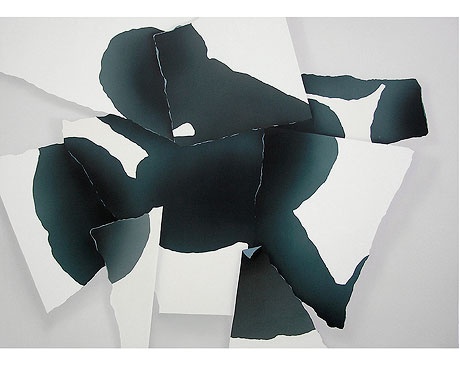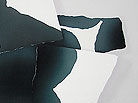Małgorzata Szymankiewicz — „Słaba widoczność” w Małej Przestrzeni

Wernisaż wystawy Małgorzaty Szymankiewicz
w Małej Przestrzeni 16 grudnia o godz. 18.00.

publikacja podsumowująca cykl „Drobnostki” Publikacja jest podsumowaniem projektu Drobnostki — zaplanowanej na cały rok płaszczyzny spotkań artystów, designerów i społeczności...

Karolina Żyniewicz — „Strach przed ciemnością” — wystawa w ramach Biennale Sztuki dla Dziecka Karolina Żyniewicz porządkuje przestrzeń bez wyraźnego zaznaczenia centrum. Rozkłada i rozwiesza obiekty zgodnie z regułami własnej geometrii....

Bartosz Kokosiński — „Niektóre obrazy nie chcą być namalowane” Najnowsze płótna Bartosza Kokosińskiego stwarzają wrażenie jakby zaledwie przed momentem coś przemieściło się pod ich powierzchnią. Swoim kształtem...

Maciej Nawrot — „Dni pędzą jak dzikie konie ze wzgórza” „Postanowiłem to namalować” — mówi Maciek. Wyczuwa się, że w obrębie wybranych przez niego kadrów, coś mogłoby się...

Oko powinno być szybkie i dobre. Nie ma czasu na zmarszczenie brwi, na opuszczenie powiek — może być za późno. Dawniej trzeba było czasu na podróż, na lekturę książki, na katastrofę na zachód słońca, zjawiska miały długość, szerokość, objętość. I to było zadowalające. Dziś przedmioty są tylko fragmentami przedmiotów..
—Fernand Leger
Przez wieki przyuczano oko do patrzenia w określony sposób. W ramach perspectiva artificialis widzenie było oczyszczone z przypadkowości, uregulowane, ujęte w karby geometrii. Już samo łacińskie słowo perspicere oznaczające przenikanie na wskroś, zapowiada badanie aż do granic, w całości, dogłębne. Jest nakazem wnikania, izolowania, wydzielania i organizowania według zasady decorum, głoszącej na co warto patrzeć i jak patrzeć. Mało uwagi w historii sztuki poświęcano natomiast temu, co ujrzane mimochodem, kątem oka. Oczami zmrużonymi, zmęczonymi czy chorymi. Patrzeniu przez zalaną deszczem szybę, przez dziurkę od klucza, spomiędzy liści. Twarz Dory Maar ma podwójny profil, bo jak wyjaśnia Picasso kiedy trzymał kochankę w ramionach tak właśnie ją widział. Czy aby wyzwolić oko potrzeba miłosnego zbliżenia? Przyglądania się rzeczom z bardzo bliska, aż zatrą się kontury i zostanie tylko kolor albo faktura.
Prace Małgorzaty Szymankiewicz powstają w opozycji do obowiązującego w sztuce paradygmatu wyraźnego widzenia. Według niego zadanie malarzy polegało na oddaniu z matematyczną precyzją odbić światła na przedmiotach. Zabiegi zobrazowania tego co niewyraźne były postrzegane nie tylko jako zagrożenie dla oka, ale i racjonalnego myślenia. W zbyt mocnym świetle, tak jak w ciemnościach i mgle znikają przeciwieństwa.
Nie można ocenić odległości, zidentyfikować miejsc ani przedmiotów. Malując rozmyte detale przypominające obrazy spod mikroskopu, Szymankiewicz odrzuca wizualną kontrolę nad światem. Badając rzeczy zatrzymuje się na ich powierzchni. Z coraz większych zbliżeń nie wynika już nic poza nieostrością, w którą ona sama może zapadać się bez końca. Rozkoszować płynną i nieregularną kompozycją, układem kolorów, kształtów i linii.
Z jednej strony, swoje obrazy maluje jakby kolekcjonowała połamane zabawki na podwórku. Raz jej uwagę przykuje pęknięte szkiełko, błyszczący papierek po cukierku, kulka z papieru, innym razem kamyk. Jedyną cechą, która łączy ten zbiór jest jej czuły ogląd.
Z drugiej, przedmioty z jej obrazów rozsiekają się. Są niekompletne, rozbite, nadłamane. Z pozoru wymagają opieki i uwagi. Tymczasem, jak przestrzegał już Jean Baudrillard okazuje się, że zaczynają grać w swoją własną grę. Lekkie spokrewnienie z rzeczywistością, od której są znacznie bardziej pociągające czyni je zaborczymi. Przysłaniając patrzący na nie podmiot, uwodzą i wssysają go w głąb siebie. W takim układzie subiektywny punkt widzenia należy odłożyć do lamusa. Patrzeć co nadchodzi od strony rzeczy, które rozrastają się w nieskończoność, potęgują aż do obsceniczności.
Kuratorka: Marta Lisok










